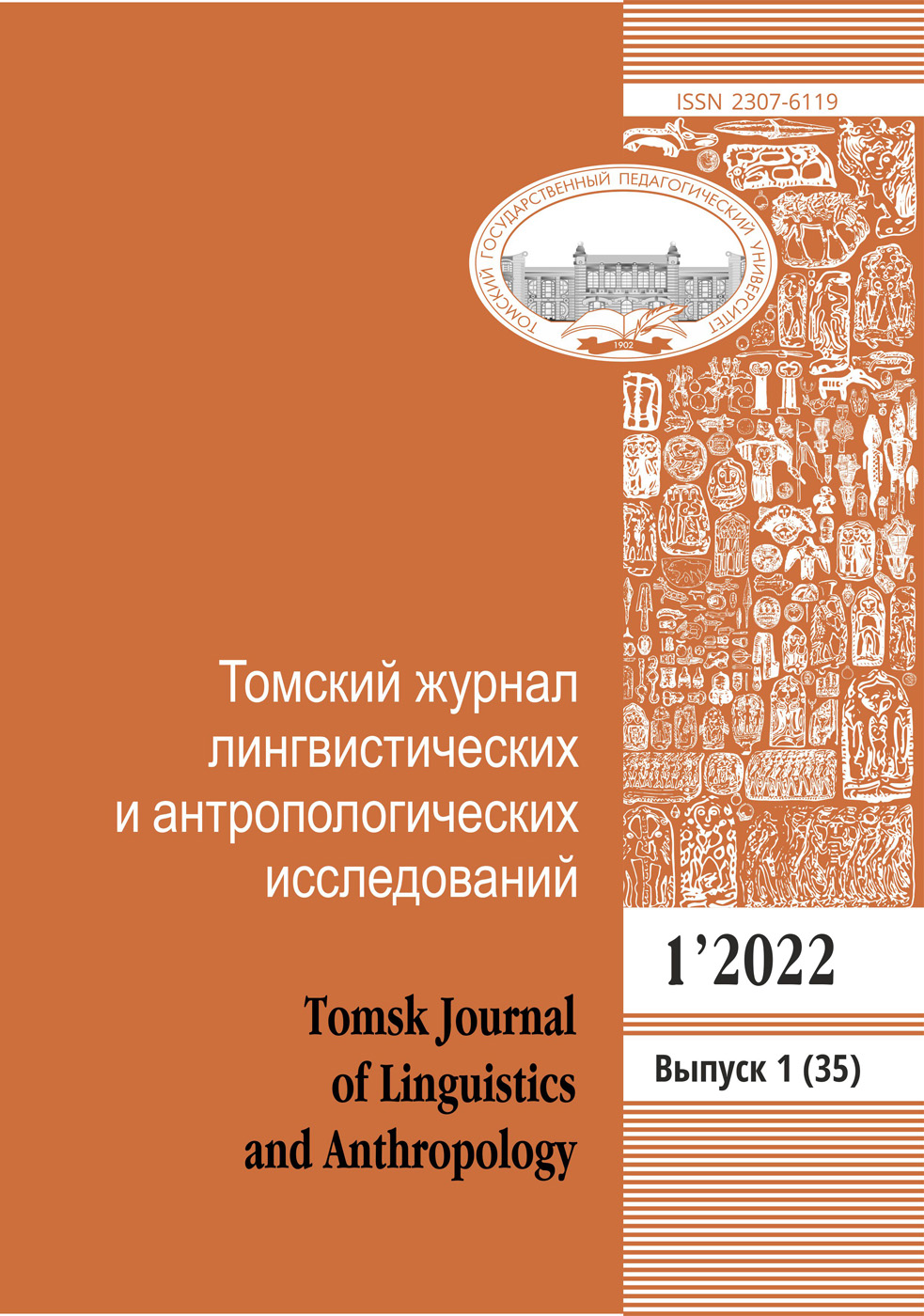FIGURE OF FIRE IN THE WORLDVIEW OF SELKUPS
Sacral and ordinary components of fire in the linguistic worldview of Selkups are specified and described. In mythoepic perception fire connects the Upper, Middle and Lower worlds. Important status of fire is represented by big amount of restrictions and rules which violation is followed by negative consequences not only for one person but for the whole generation. In Selkup lexical unit tǖ ‘fire’ relates to animate nouns, and fire itself is perceived by Selkup as a living organism. As any other living organisms, fire is born, lives and dies. As a moment of birth of fire shall be considered a moment of its kindling – innä cotyqo ‘to kindle’. To support its life fire needs a feed – wood (tǖj apsot). The process of burning is to be considered as a continuous repast of fire: tǖ awēšpįgu ‘to burn’, literally tǖ ‘fire’, awēšpįgu ‘to eat’. Life cycle is finished by “death” of fire – extinction: illä qapteǯegu ‘to extinct’. Fire is given with vivific power and ability to wake the dead. In folk literature and Selkup mythology fire is personified with the figure of Lady of fire (tǖn amba).
Keywords: Selkup language, language worldview, fire, figure, personification, connection of worlds
References:
1. Polyakova N. V. “Osobye mesta” v kartine mira sel’kupskogo etnosa [“Sacred places” in the worldview of the Selkups]. Vestnik Tomskogo gosudarstvennogo pedagogicheskogo universiteta – TSPU Bulletin, 2012, vol. 10 (125), pp. 85–88 (in Russian).
2. Polyakova N. V. Kontseptualizatsiya atmosfernykh osadkov v sel’kupskom yazyke v sopostavlenii s russkim [The conceptualization of the atmospheric precipitation on the Selkup language in comparison with the Russian language]. Tomskiy zhurnal lingvisticheskih i antropologicheskih issledovaniy – Tomsk Journal of Linguistics and Anthropology, 2013, vol. 2 (2), pp. 69–74 (in Russian).
3. Kuznetsova A. I., Helimskiy E. A., Grushkina E. V. Ocherki po sel’kupskomu yazyku. Tazovskiy dialekt [Essays about the Selkup language. Tazovsky dialect]. Moscow, MGU Publ., 1980. Vol. 1. 408 р. (in Russian).
4. Sel’kupsko-russkiy dialektnyy slovar’ [Selkup and Russian dialect dictionary]. Pod red. prof. V. V. Bykoni [Under the editorship of professor V. V. Bykonya]. Tomsk, TSPU Publ., 2005. 348 p. (in Russian).
5. Baydak A. V. Sredstva vyrazheniya kategorii odushevlennosti/neodushevlennosti v sel’kupskom yazyke [Methods of expression of animate/inanimate categories in the Selkup language]. Vestnik Tomskogo gosudarstvennogo universiteta – TSU Bulletin, 2010, no. 338, pp. 7–12 (in Russian).
6. Mifologiya sel’kupov [Selkup mythology]. Scientifi c editor V. V. Napolskih]. Tomsk, TGU Publ., 2004. 382 p. (in Russian).
7. Skazki narymskikh sel’kupov: kniga dlya chteniya na sel’kupskom yazyke s perevodami na russkiy yazyk [Fairy tales of selkup natives of the Narymsk region: book for reading in the Selkup language with the Russian translation]. Zapisi, per., komment. V. V. Bykoni, A. A. Kim i dr. [Records, translation, comments of V. V. Bykonya, A. A. Kim etc.]. Tomsk, NTL Publ., 1996. 187 p. (in Russian).
8. Shargorodskiy L. T. Sel’kupy. Sovremennye etnicheskiye protsessy u sel’kupov [Selkups. Modern ethnic processes of Selkups]. Moscow, Nauka Publ., 1994. 186 p. (in Russian).
9. Baydak A. V. Eksperimental’nye metody issledovaniya kontseptov “zhizn’” i “smert’” [Experimental methods of studying of concepts “Life” and “Death”]. Izvestiya Tomskogo politehnicheskogo universiteta – Bulletin of Tomsk Polytechnic University, 2010, vol. 316, no. 6, pp. 228–232 (in Russian).
Issue: 6, 2016
Series of issue: Issue 6
Rubric: LANGUAGES OF THE PEOPLES OF THE RUSSIAN FEDERATION
Pages: 54 — 57
Downloads: 728





